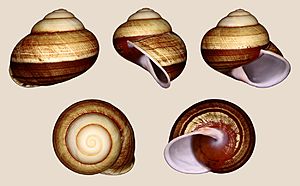Calocochlia pan facts for kids
Quick facts for kids Calocochlia pan |
|
|---|---|
 |
|
| Five views of a shell of Calocochlia pan | |
| Scientific classification | |
| Kingdom: | |
| Subkingdom: | |
| Phylum: | |
| Class: | |
| (unranked): |
clade Heterobranchia
clade Euthyneura clade Panpulmonata clade Eupulmonata clade Stylommatophora informal group Sigmurethra |
| Superfamily: |
Helicoidea
|
| Family: |
Bradybaenidae
|
| Genus: |
Calocochlia
|
| Species: |
C. pan
|
| Binomial name | |
| Calocochlia pan Broderip, 1841
|
|
Calocochlia pan is a type of large land snail. It breathes air, just like us! This snail is a kind of mollusk, which is a group of animals that includes snails, slugs, and clams. It belongs to a family called Bradybaenidae.
You can find Calocochlia pan snails very often in the Philippines. They are quite common there.
Contents
What Does It Look Like?
The shell of a Calocochlia pan snail is pretty big. It can be between 41 and 47 millimeters long. That's about the length of two quarter coins!
The shell has a lovely design. It has brown bands that spiral around it. The main color of the shell is a creamy white. This makes the brown bands stand out nicely.
Where Do They Live?
These snails are found in the Philippines. They live on land, often in places where there is moisture. Like many snails, they prefer humid environments. They might be found in gardens or forests.
What Do They Eat?
Most land snails, including Calocochlia pan, are herbivores. This means they eat plants. They might munch on leaves, decaying plant matter, or even fungi. They use a special ribbon-like tongue called a radula to scrape their food.
Life of a Snail
Snails move slowly using a muscular foot. They leave a trail of slime behind them. This slime helps them glide and protects them from sharp surfaces.
Snails are important parts of their ecosystem. They help break down dead plant material. They also serve as food for other animals.
Discovery of Calocochlia pan
This snail was first described in 1841. It was named by a scientist called William Broderip. Scientists give each species a unique name. This helps everyone know exactly which animal they are talking about.
See also
 In Spanish: Calocochlia pan para niños
In Spanish: Calocochlia pan para niños

